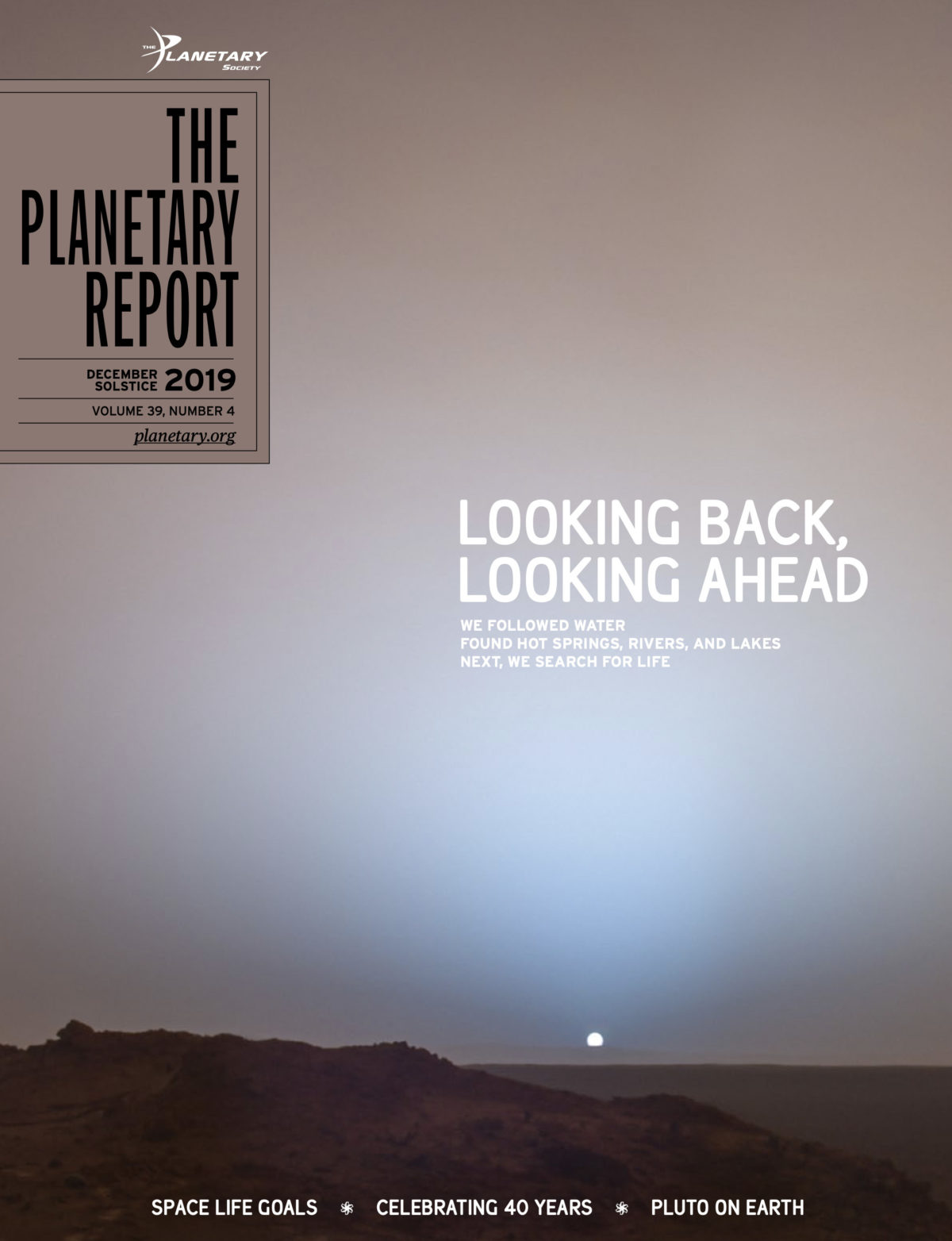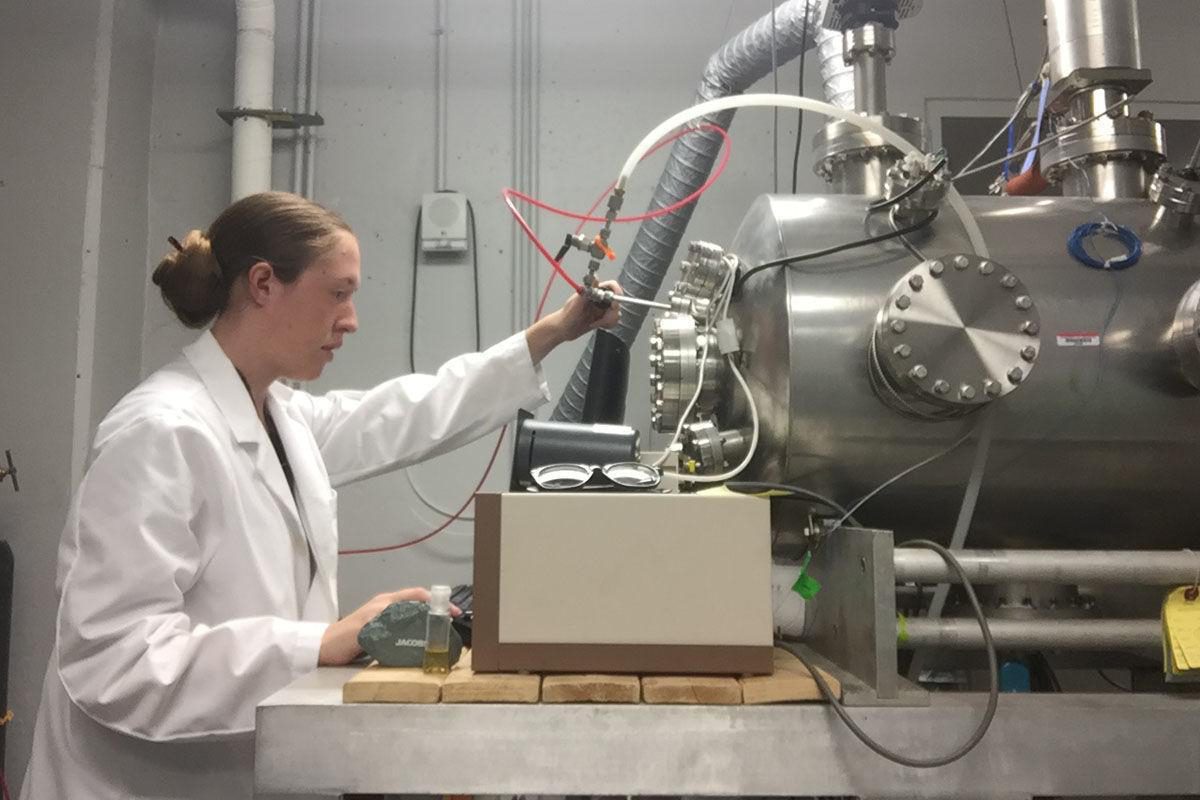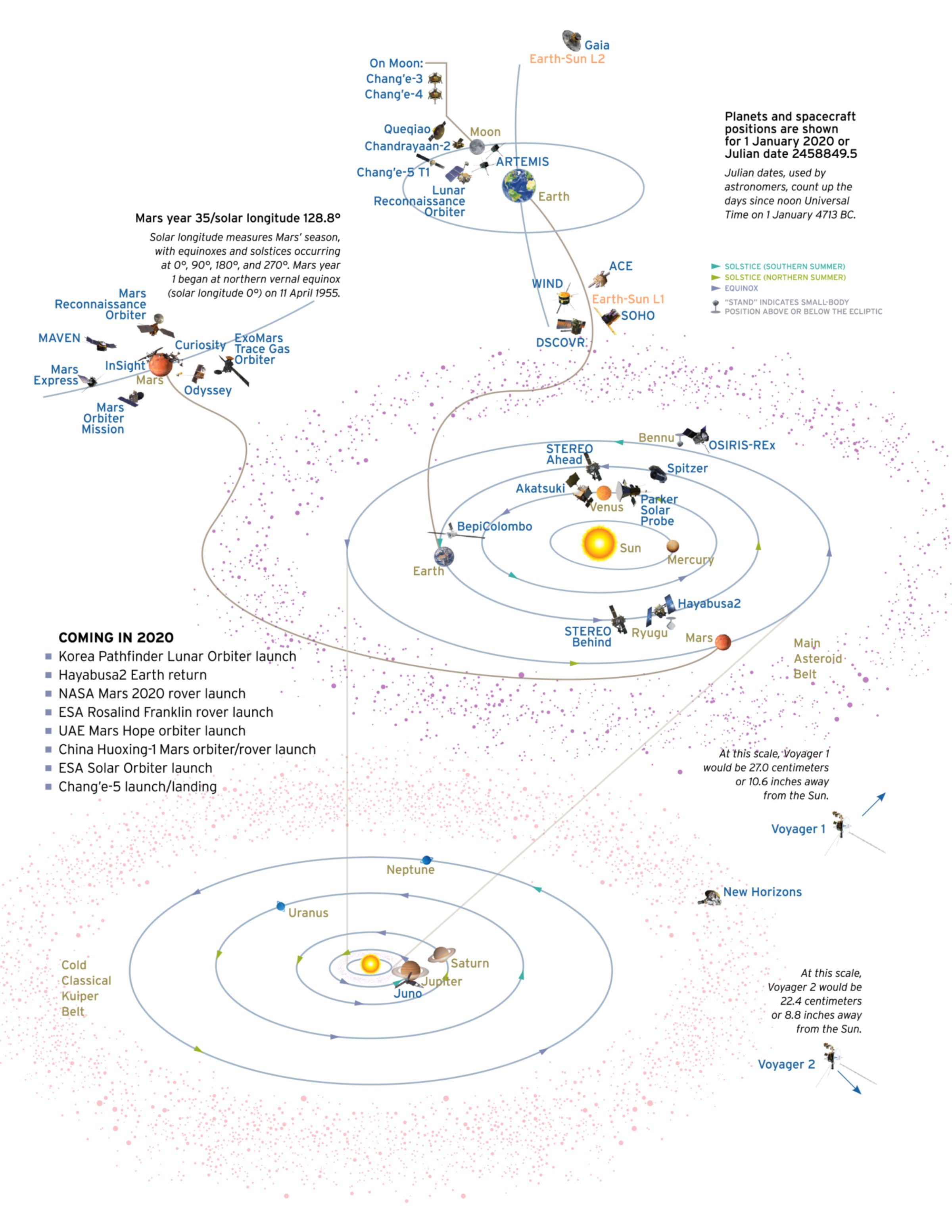
On the Cover: The Sun sets below a fan of blue in a brown sky over the mountainous rim of Gusev crater, Mars. The Mars Exploration Rover Spirit took this photo on 19 May 2005.
Download PDF
Feature
A New Understanding
Abigail Fraeman examines how Spirit and Opportunity changed our view of Mars.
Feature
What Comes Next on Mars?
Javier Gómez-Elvira anticipates the next phase of the search for life on the Red Planet.
Your Place In Space, Your Impact
People. Passion. Planets.
Bill Nye revels in 4 decades of bringing space to everyone, and we celebrate our global membership.
Space on Earth
Deep Freezer: Simulating Chemical Processes on Far-Away Worlds

Doctoral student Caitlin Ahrens works in the Pluto lab at the University of Arkansas. The machine can simulate Pluto’s surface temperature (34 to 54 kelvins, or -239 to -219 Celsius, or -398 to -362 Fahrenheit) and pressure (14 microbars, or 14 millionths of Earth surface pressure). It has a separate chamber for mixing carbon monoxide, methane, and nitrogen gases in different proportions before Ahrens introduces them to the Pluto chamber to observe how they would behave on Pluto, helping scientists to interpret New Horizons’ observations of Pluto’s surface composition. While scientists have studied the behavior of the individual ices before, how they interact with each other is not well understood.
Pluto has a huge variety of surface textures with large, blotchy regions of different kinds of ices. In the Pluto lab, investigating these ices helps to understand how they form crystals and how those crystals change with temperature and pressure. Spectrometers can see how light of different wavelengths interacts with the crystals, so Pluto lab experiments will help Ahrens and her coworkers to interpret the data from spacecraft and Earth-based telescopes. They can also study how shifts in Pluto’s climate affect its ices. Eventually, the work with this Pluto lab will lead to other experiments investigating how these different ices behave as the geologic materials that form Pluto’s diverse landforms.
Snapshots from Space
Triton Awaits Future Exploration
Neptune's Moon Triton, nearly as large as our own moon, probably began its existence in the Kuiper belt. It’s covered by the same kinds of ices as Pluto: solid forms of water, methane, nitrogen, and carbon-rich gunk. It’s been 30 years since Voyager 2 flew past, seeing only its southern hemisphere. If Earth were to begin developing a Neptune orbiter mission soon, we could arrive in the 2040s, when the Neptune system would be near equinox, and the entire surface of the moon would be sunlit over the course of its day.
Get Involved
What Are Your Space Life Goals?
In 2020, join us in building the ultimate list of life goals for space enthusiasts. Have you ever witnessed a rocket launch or observed Jupiter’s moons through a telescope? If not, do you want to? You can help give space enthusiasts a way to track their experiences and be inspired to share their excitement, whether they’re a lifelong space geek or a newfound fan.
What are the greatest space things you’ve seen and done? What experiences caused your interest in space? What are the absolute must-sees and must-dos for a space fan like you?
Between now and 31 January 2020, send us your creative ideas for ways to experience space. Share your space life goal suggestions at planetary.org/spacegoals.
Your Guide to Year-End Giving for Space Exploration
You can make a difference in our mission by making a gift to advance space science and exploration.
Give cash: use your credit or debit card at planetary.org/donate or mail a check in the provided envelope.
Corporate gift matching: use our lookup tool to see if your company participates.
Get a tax break: make an IRA-qualified charitable distribution.
Give stock: contact [email protected] for instructions for your broker.
IMPORTANT DEADLINES
For U.S. tax purposes, gifts must be received on or before the last day of the year. Here are some common methods of making a gift and their associated deadlines.
ONLINE CREDIT CARD GIFTS: transaction completed by 11:59 p.m. EST (8:59 p.m. PST), 31 DecCHECKS SENT VIA U.S. MAIL: postmarked on or before 31 Dec
CHECKS SENT VIA THIRD-PARTY SHIPPING (SUCH AS FEDEX OR UPS): delivered on or before 31 Dec
CREDIT CARD GIFTS VIA U.S. MAIL: received and processed on or before 31 Dec
STOCK TRANSFER: broker-to-broker instructions issued in time for completed transfer on or before 31 Dec
What's Up?
In the Sky
The Quadrantids, an above-average meteor shower, peak on the night of 3 to 4 January. From a dark site, one may see as many as 40 meteors per hour. The best viewing occurs after the Moon sets around midnight. Super-bright Venus dominates the West after sunset. Dimmer Mercury is to its lower right in early February. Reddish Mars is in the East before dawn. By February, bright Jupiter and yellowish Saturn have joined it to Mars’ lower left. In March, the 3 planets dance close together with Mercury to their lower left. On 18 March, the crescent Moon joins Jupiter, Mars, and Saturn in a tight grouping.
Random Space Fact
The distance from Earth to the Moon is about the same as the distance traveled around Earth 10 times.
Trivia Contest
Our June solstice contest winner is David Lee Summers of Mesilla Park, New Mexico. Congratulations! The question was: What was the first spacecraft mission to return samples from a comet? The answer: The Stardust mission.

Try to win a copy of Super Cool Space Facts: A Fun, Fact-filled Space Book for Kids by Bruce Betts and a Planetary Radio T-shirt by answering this question:
In January 2019, Chang’e-4 became the first spacecraft to soft-land on the far side of the Moon, but what was the first spacecraft to impact on the far side of the Moon?
Email your answer to [email protected] or mail your answer to The Planetary Report, 60 S. Los Robles Ave., Pasadena, CA 91101. Make sure you include the answer and your name, mailing address, and email address (if you have one). By entering this contest, you are authorizing The Planetary Report to publish your name and hometown. Submissions must be received by 1 March 2020. The winner will be chosen in a random drawing from among all the correct entries received.
For a weekly dose of “What’s Up?” complete with humor, a weekly trivia contest, and a range of significant space and science-fiction guests, listen to Planetary Radio at planetary.org/radio.
Where We Are
An At-A-Glance Spacecraft Locator

In the first quarter of 2020, there will be one interplanetary launch—ESA’s Solar Orbiter, which is planned to go up on an Atlas 5 rocket from Cape Canaveral on or after 5 February. It will travel close to the Sun to study the inner heliosphere. While it won’t get as close to the Sun as Parker Solar Probe does, Solar Orbiter will enjoy an unusual polar orbit.
We’ll lose one interplanetary spacecraft this quarter when the great Spitzer Space Telescope ends its mission with a planned shutdown on 30 January.
Sadly, the Indian Space Research Organisation (ISRO)’s Vikram lander crashed on 6 September, but it did successfully test a number of new technologies before it tumbled out of control. The Chandrayaan-2 orbiter is operating well and could last for as many as 7 years at the Moon, ISRO said.
Orbiters are sending science data from Venus, the Moon, a near-Earth asteroid, Mars, and Jupiter. There are two active Mars landers and two active lunar landers. Hayabusa2 departed asteroid Ryugu on 15 November to return its samples to Earth. Parker Solar Probe flies past Venus on 26 December. BepiColombo is catching up with Earth on the inside track toward a 13 April flyby.
Back on Earth, space agencies around the world are scrambling to prepare for the opening of the summer 2020 Mars launch opportunity. Three rovers (NASA’s Mars 2020, ESA’s Rosalind Franklin, and China’s Huoxing-1) are undergoing final preparations for launch. Last-minute problems could delay the launch until 2022, so the stakes are high.
Why I Explore
A Life of Learning

People often ask me why I became an astronomer. I think it started with the sciencefiction books I collected when I was young. They were more than a library. They became an obsession when I was a teenager—a way to escape the harsh reality of life as a person of color in France and in a world that I thought was on the verge of destruction.
In books, I could imagine a world that mastered faster-than-light propulsion, explored new planets, started conflicts, created egalitarian societies, found weird life, and communicated with extraterrestrials. I explored within my mind first and then joined the space exploration community. Luckily, I lived in Toulouse, France, the European capital of aerospace, where I met astronomers and astronauts who told me their stories and explained why they explored.
Shortly after the discovery of an exoplanet orbiting 51 Peg, I heard about adaptive optics (AO) and how it could help astronomers tap the full potential of ground-based telescopes. I quickly decided to dedicate my career to AO. Today, AO has lowered the cost of space exploration and has enabled new discoveries, including moons around asteroids and the first picture of a Jupiter-like exoplanet.
Astronomy is far more than a research field. It also has a huge impact on our civilization. My generation was motivated by the iconic picture of our pale blue dot taken by Voyager 1 in 1990. It made us realize that the solar system is our backyard, and Earth is not the limit. The recent flyby of Pluto, once called the ninth planet, is just one consequence of this image.
Today, AO is everywhere, including on every large telescope, but we have only begun to tap its huge potential. We are building another generation of extremely large telescopes that use AO, and we are even considering bringing AO to space with Project Blue and ambitious concepts like HabEx and LUVOIR. Someday, one of these telescopes will take an image of another pale blue dot, which will tell that somewhere around a nearby star, there is a world like ours—a planet with a liquid ocean, a biosphere, and perhaps intelligent life. We will learn a lot from studying this planet—about the past and future of our Earth, about life, and about intelligence. We might find out that indeed, we are not alone.
What a feast this will be for astronomers, anthropologists, sociologists, and others! If these extraterrestrials confronted and overcame the same issues we face today, we may find an answer to our problems by learning from these older siblings. We may also realize that we are not a plague in the universe but an inevitable evolution of intelligence. If and when this happens, it will take me back to stories I read in my science-fiction books and my earliest drive to explore.
Astronomical Art
"Life on Mars: Cave Colonies" by Adrianna Allen

Adrianna Allen, a scientific illustrator, envisions future astronauts encountering Mars life. About this digital painting, she writes: “As she descended farther into the cave, what was detected in the initial scans suddenly became obvious to her eyes. There indeed had been water trapped here once. The Red Planet was about to reveal its most wondrous secret.” See more of her work at photonillustration.com.Image: © Adrianna Allen
The surface of Mars is an extremely hostile environment for life. It experiences radiation by high-energy particles from the Sun and space and is drier than the most arid Earth desert. If life exists on Mars today, it would be better off below ground, sheltered from radiation, where there may be liquid water. Human astronauts may one day look for both shelter and water underground.
Adrianna Allen, a scientific illustrator, envisions future astronauts encountering Mars life. About this digital painting, she writes: “As she descended farther into the cave, what was detected in the initial scans suddenly became obvious to her eyes. There indeed had been water trapped here once. The Red Planet was about to reveal its most wondrous secret.” See more of her work at photonillustration.com.
The Planetary Report • December Solstice 2019
Help advance space science and exploration! Become a member of The Planetary Society and you'll receive the full PDF and print versions of The Planetary Report.


 Explore Worlds
Explore Worlds Find Life
Find Life Defend Earth
Defend Earth

